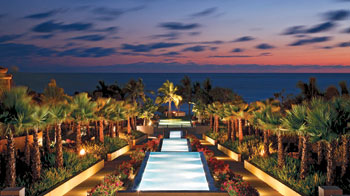This post may contain affiliate links. We may earn money or products from the highlighted keywords or companies or banners mentioned in this post.
March 23, 2015 By: Elaine Yetzer Simon
 |
| The St. Regis Punta Mita, the first St. Regis property in Latin America, opened in 2008. The 120-room resort was a joint venture between Starwood Hotels & Resorts Worldwide and Ideurban Consultores. |
When discussing the hotel industry in Mexico, the word that keeps popping up over and over is “opportunity.” Whether it’s the Mexican government, hotel companies or analysts doing the talking, the theme is the same: It’s a great time to open a hotel south of the border.
Tourism is one of the biggest contributors to Mexico’s gross domestic product, accounting for 8.4 percent of it, according to Alejandro Vazquez, director of CNET, Mexico’s national tourism business council.
“The real story is that tourism is one of the largest generators of wealth, foreign exchange and jobs, and the hotel industry specifically is a pillar for tourism,” he said. “As the number of visitors increases, so must the number of available rooms, making it a very profitable industry full of opportunities for both the government and private initiatives.”
Hilton Worldwide, which has 33 properties and more than 5,700 guestrooms open in Mexico, manages and franchises hotels in the country.
“As one of the largest economies in Latin America, Mexico affords great opportunities for the travel industry,” said George Massa, VP of development, Mexico and Central America, for Hilton Worldwide. “With steady foreign investment, improvements in infrastructure through the National Infrastructure Plan, growth in industries, such as the automotive industry, and a continued push to promote tourism via campaigns in key source markets and simplify the visa process, Mexico continues to be a major focus for our development efforts.”
Mexico has potential at all price points, according to Starwood Hotels & Resorts Worldwide, which has 28 hotels and 10,708 guestrooms open in the country.
“Mexico is our seventh most important market in the world in terms of size and revenue,” said Victor Vazquez, VP of acquisitions and development at Starwood Latin America. “It is also the only country in the region where our footprint spans eight brands, covering the specialty-select, upper-upscale and luxury segments. In fact, it is the only country where all of our luxury brands are present.”
Increasing demand makes this an ideal time to expand, according to Alejandro Vazquez.
“Mexico has the natural, cultural and human resources to make the hotel industry one of the biggest,” he said. “Now, the government needs to work hand in hand with the hoteliers to develop new destinations and new hotels.”
Performance
Preliminary data for 2014 show that occupancy was 57.3 percent, average daily rate (ADR) reached $136 and revenue per available room (RevPAR) was $78, according to Alberto Garcia, director of statistics at the Mexico Ministry of Tourism. In addition, about 75.3 million room nights were sold during the year.
According to Gregory Rumpel, managing director at Jones Lang LaSalle Hotels, there are about 3,400 hotels and nearly 350,000 guestrooms in Mexico. About 17 percent of those rooms fall under U.S. parent companies, such as Marriott International and Hilton Worldwide, and the remaining branded hotels (which equal 40 percent of supply) are regional brands.
The hotel segment continues to do better coming out of the recession, according to Scott Smith, managing director of valuation and advisory at PKF Consulting.
“As their economy recovers, their hotels have started to recover from an occupancy and ADR side,” he said. “With no real new supply in the market, the hotels are able to reach a certain occupancy where now they’re able to increase their room rates above the rate of inflation.”
The small number of hurricanes in 2014, a decrease in news about crime in the country, the absence of SARS and continued good airlift are factors in strengthening the Mexican tourism scene, Smith said. In addition, he said the government has done a very good job promoting the cultural aspects of the destination, which furthers tourism interest.
Through the third quarter of 2014, InterContinental Hotels Group’s properties in Mexico saw an increase of 1.6 points in occupancy and 2.8 percent in rooms occupied, leading to RevPAR growth of 7 percent, according to Gerardo Murray, regional VP of distribution and commercial marketing, Mexico, Latin America and the Caribbean, for IHG.
Investment / Development
The Mexican government plays a big role in the success of the hotel industry.
“There are approximately 70 hotel companies working in Mexico, and all of them receive assistance from the government to operate,” Alejandro Vazquez said. “In specific cases, such as the hurricane disaster in Cabo last September, the government offers tax deductions and incentives to promote the growth of this specific destination.”
Bancomext, a government entity, is focused on lending money to support hotel development in the country, according to Rumpel.
Transaction activity has heated up recently, going from a low of less than $100 million in 2009 to $600 million in 2013, according to Jones Lang LaSalle’s Hotels & Hospitality Group. The group predicted transaction volume of $700 million for 2014.
“The action has been in transactions with players such as the Mexican [real-estate investment trust]-like structures known as fibras and related entities, such as CKDs,” according to Rumpel. “Fibras have formed partnerships with global hotel companies, such as Marriott International, and developers to expand their hotel portfolio across key primary and secondary markets in Mexico.”
Mexican ownerships tend to have long-term holdings, which affects the number of properties changing hands, according to Smith.
“They may hold a property for generations; the ownership is more family-oriented as opposed to corporate LLCs,” he said. “The transaction velocity is not as high in Mexico as it would be in the U.S.”
In general, it’s their investment culture not to overleverage a property, according to Smith.
“They provide the majority of the capital, maybe up to 50 percent of the capital cost to construct a new property,” he said. “A developer here in the U.S. may only require 25 percent to 30 percent equity to get a new construction started. When you have the down cycle [like] we just had, they’re able to keep those properties.”
The equity in the hotel industry comes from a variety of places: fibras, CKDs, local private-equity funds, local construction companies and local families, according to Rumpel and Smith. Both predict that more international groups will move into the country in the near future.
The government also has taken steps to advance tourism because of its role as a major engine of economic growth.
“Mexico has very limited barriers to development and this creates a positive scenario for the industry,” Victor Vazquez said. “Most recently, the lifting of visa requirements with other Latin American countries, such as Brazil, Chile, Peru and Colombia, as a result of the Pacific Alliance, will also help to promote travel between these countries.”
Pipeline Projections
According to Alejandro Vazquez, Mexico’s national tourism board predicts that, by 2024, the country will have to build an average of 180,000 new rooms to meet its demand. That’s an increase of 70 percent from the market today.
There is a lack of institutional-quality hotel inventory available for big portfolios, according to Rumpel, and the opportunity will be for those who are willing to develop new hotels. He said there are about 7,000 guestrooms under construction in Mexico, which is 2 percent of existing supply. The entire active development pipeline makes up 5 percent of existing supply, but it’s common for some projects not to be completed, he said.
Smith said that labor and construction costs are still low in Mexico, and are increasing at a slower rate than in the U.S., which makes this a good time to build. He predicts that supply growth will be 1 percent to 1.5 percent during the next two or three years, which is below long-term additions to supply as a percentage of growth.
“There’s a good opportunity right now on the leisure side to look at future development as construction costs and land costs still try and catch up,” he said. “On the corporate side, there are still opportunities for all of the brands and the developers to develop select-service or focused-service properties.”
Hilton is continuing its focus on the country with a number of projects.
“Hilton Worldwide currently has nearly 30 hotels and more than 3,300 guestrooms in the development pipeline for Mexico,” Massa said. “Hilton Worldwide recognizes the importance of expanding our presence in Mexico and we are constantly evaluating opportunities to introduce our industry-leading brands throughout the country, in both city center and resort destinations.”
Starwood’s development mantra is to focus on the right brand, the right location and the right partner, according to Vazquez.
“We want to continue to grow in Mexico and believe that there is still great opportunity in secondary cities and undiscovered vacation destinations,” he said. “Recently, we have begun work with Mexican fibras, which are investment trusts dedicated to the acquisition and development of hotels. We believe that this will also be a great source of opportunity for us to develop new hotels in the country.”
Starwood has seven hotels opening in the next few years, including Las Alcobas, a Luxury Collection Hotel, Mexico City, which will open March 1, and the Westin Cozumel, scheduled to open in 2016. Others to open in 2017 are the W Retreat & Spa Kanai, and Solaz, a Luxury Collection Hotel, Los Cabos.
According to Murray, IHG’s growth in the country is promising, with 29 hotels and 3,576 guestrooms in the pipeline.










